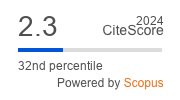THERMAL SCIENCE
International Scientific Journal
Thermal Science - Online First
online first only
Evaluating the efficacy of external shading devices on building energy consumption: A case study in hot climate
ABSTRACT
The study investigates the impact of external shading devices on the energy consumption of an existing building in hot desert climate. Utilizing EnergyPlus and OpenStudio simulation software, an in-depth analysis was conducted on a two-story rectangular building, with meticulously collected onsite weather data ensuring accurate simulation inputs. A total of six shading configurations were examined to ascertain their role in minimizing energy consumption over different periods of the year. The results revealed that all examined shading devices led to some level of reduction in annual energy consumption, with the egg crate type shading device (SD-6) achieving the highest reduction in annual energy consumption by 0.9% and cooling load by 1.38 %. Additionally, the study highlights the significant role of site-specific factors, such as the presence of adjacent buildings, which can influence overall energy performance. In this case, a nearby taller building cast a shadow over the study building, thereby reducing the cooling load during peak hours and impacting the building's energy performance. The research's comprehensive approach, which includes analysis over different timeframes, demonstrates the effectiveness of shading devices as passive design strategies for reducing energy consumption and emphasizes the necessity of incorporating local climatic conditions and urban environments into building designs. This comprehensive approach is vital in achieving optimal energy efficiency in buildings located in hot climates.
KEYWORDS
PAPER SUBMITTED: 2024-08-03
PAPER REVISED: 2025-02-07
PAPER ACCEPTED: 2025-02-25
PUBLISHED ONLINE: 2025-05-10
- Bande, L., et al., Housing programmes in UAE: case study analysis based on regional sustainable standards and local microclimate, Journal of Physics: Conference Series, Climate Resilient Cities - Energy Efficiency & Renewables in the Digital Era, EPFL Lausanne, Switzerland, 2019, 1343, pp. 012027 doi.org/10.1088/1742-6596/1343/1/012027
- Hammad, F., Abu-Hijleh, B., The energy savings potential of using dynamic external louvers in an office building, Energy and Buildings, 42 (2010), 10, pp. 1888-1895 doi.org/10.1016/j.enbuild.2010.05.024
- Kapur, N.K., A comparative analysis of the radiant effect of external sunshades on glass surface temperatures. Solar Energy, 77 (2004), 4, pp. 407-419 doi.org/10.1016/j.solener.2003.09.016
- Dubai Municipality, Al Sa'fat Dubai Green Building System: Practice Guide, Dubai, 2020
- Chandrasekaran, C., et al., Energy-efficient retrofitting with exterior shading device in hot and humid climate - case studies from fully glazed multi-storied office buildings in Chennai, India, Journal of Asian Architecture and Building Engineering, (2022), pp. 1-15 doi.org/10.1080/13467581.2022.2145208
- Kirimtat, A., et al., Review of simulation modeling for shading devices in buildings, Renewable and Sustainable Energy Reviews, 53 (2016), pp. 23-49 doi.org/10.1016/j.rser.2015.08.020
- Li, Y., Tao, X., Zhang, Y., Li, W., Combining use of natural ventilation, external shading, cool roof and thermal mass to improve indoor thermal environment: Field measurements and simulation study, Journal of Building Engineering, 86 (2024) 108904. doi.org/10.1016/j.jobe.2024.108904
- Fadzil, S.F.S., Sia, S.J., Recommendations for Horizontal Shading Depths for Vertical Building Facades in the Tropic Region with particular reference to Penang, Malaysia, Architectural Science Review, 46 (2003), pp. 375-381 doi.org/10.1080/00038628.2003.9697009
- Bellia, L., et al., An Overview on Solar Shading Systems for Buildings, Energy Procedia, 62 (2014), pp. 309-317 doi.org/10.1016/j.egypro.2014.12.392
- Bellia, L., et al., Effects of solar shading devices on energy requirements of standalone office buildings for Italian climates, Applied Thermal Engineering, 54 (2013), 1, pp. 190-201 dx.doi.org/10.1016/j.applthermaleng.2013.01.039
- Ma,Z., Cooper, P., Daly, D., Ledo,L., Existing building retrofits: Methodology and state-of-the-art, Energy and Build, 55 (2012), pp. 889-902 doi.org/10.1016/J.ENBUILD.2012.08.018
- Szokolay, S V., Solar Geometry, Passive and Low Energy Architecture International, Brisbane, Australia. 2007
- Trimble. SketchUp Pro 2021 sketchup3d.de/download/alle/
- National Renewable Energy Laboratory, Openstudio, CO, USA www.openstudio.net/downloads
- Office of Energy Efficiency and Renewable Energy, Energy Plus, United States Department of Energy www.energy.gov/eere/buildings/downloads/energyplus-0
- Mushtaha, E., et al., The impact of passive design strategies on cooling loads of buildings in temperate climate, Case Studies in Thermal Engineering, 28 (2021), pp. 101588 doi.org/10.1016/j.csite.2021.101588

